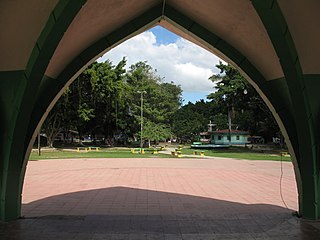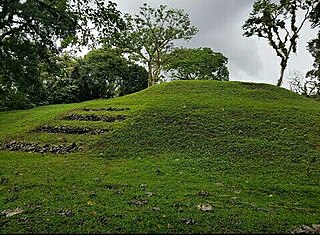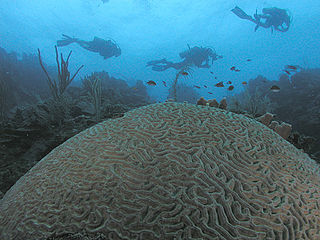
Honduras, officially the Republic of Honduras, is a country in Central America. Honduras is bordered to the west by Guatemala, to the southwest by El Salvador, to the southeast by Nicaragua, to the south by the Pacific Ocean at the Gulf of Fonseca, and to the north by the Gulf of Honduras, a large inlet of the Caribbean Sea. Its capital and largest city is Tegucigalpa.

Honduras was inhabited by many indigenous peoples when the Spanish arrived in the 16th century. The western-central part of Honduras was inhabited by the Lencas, the central north coast by the Tol, the area east and west of Trujillo by the Pech, the Maya and Sumo. These autonomous groups maintained commercial relationships with each other and with other populations as distant as Panama and Mexico. Honduras has ruins of several cities dating from the Mesoamerican pre-classic period that show the pre-Columbian past of the country.

The United Fruit Company was an American multinational corporation that traded in tropical fruit grown on Latin American plantations and sold in the United States and Europe. The company was formed in 1899 from the merger of the Boston Fruit Company with Minor C. Keith's banana-trading enterprises. It flourished in the early and mid-20th century, and it came to control vast territories and transportation networks in Central America, the Caribbean coast of Colombia, and the West Indies. Although it competed with the Standard Fruit Company for dominance in the international banana trade, it maintained a virtual monopoly in certain regions, some of which came to be called banana republics – such as Costa Rica, Honduras, and Guatemala.

Puerto Cortés, originally known as Puerto de Caballos, is a port city and municipality on the north Caribbean coast of Honduras, right on the Laguna de Alvarado, north of San Pedro Sula and east of Omoa, with a natural bay. The present city was founded in the early colonial period. It grew rapidly in the twentieth century, thanks to the then railroad, and banana production. In terms of volume of traffic the seaport is the largest in Central America and the 36th largest in the world. The city of Puerto Cortés has a population of 73,150.

Cortés is one of the 18 departments of Honduras. The department covers an area of 3,954 km² and, in 2015, had an estimated population of 1,612,762, making it the most populous in Honduras. The Merendón Mountains rise in western Cortés, but the department is mostly a tropical lowland, the Sula Valley, crossed by the Ulúa and Chamelecon rivers.

La Ceiba is a municipality, the capital of the Honduran department of Atlántida and a port city on the northern coast of Honduras in Central America. It is located on the southern edge of the Caribbean, forming part of the south eastern boundary of the Gulf of Honduras. With an estimated population of 209,000 living in approximately 170 residential areas, it is the fourth most populous and third most important city in the country.

Cristóbal de Olid was a Spanish adventurer, conquistador and rebel who played a part in the conquest of the Aztec Empire and present-day Honduras.

Trujillo is a city, with a population of 22,750, and a municipality on the northern Caribbean coast of the Honduran department of Colón, of which the city is the capital.

La Lima is a city, with a population of 80,740, and a municipality in the Honduran department of Cortés.

La Campa is a municipality and an aldea, or small town, in the Honduran Department of Lempira, located about 18 kilometres (11 mi) by dirt road from Gracias, the largest town in the immediate region.

Railroads in Honduras were built in late 19th and early 20th centuries by two competing U.S. corporations - United Fruit and Standard Fruit. All were in the Caribbean coastal area and never reached the capital. In 1993, the combined network had 785 km (488 mi). At present (2006), only three separate segments remain in operation under the management of FNH - Ferrocarril Nacional de Honduras:
Liga Mayor de Honduras is the third division of football in Honduras. It is composed of separate departmental leagues. The league is divided into two regions, North and South. Both regions are further divided into two groups. Promotion to Liga de Ascenso de Honduras is decided by a promotion final in each region. The finalist of said promotion final, are winners of each of their respective group. The groups are composed of departmental champions. One team from each region is promoted to Liga de Ascenso de Honduras, two in total.

Gil González Dávila or Gil González de Ávila was a Spanish conquistador and the first European to explore present-day Nicaragua.
Francisco de las Casas y Saavedra (1461–1536) was a Spanish Conquistador in Mexico and Honduras.

Banana production in Honduras plays an important role in the economy of Honduras. In 1992, the revenue generated from banana sales amounted to US$287 million and along with the coffee industry accounted for some 50% of exports. Honduras produced 861,000 tons of bananas in 1999. The two corporations, Chiquita Brands International and the Dole Food Company are responsible for most Honduran banana production and exports.

Honduras has been inhabited by a number of indigenous peoples, the most powerful of which, until the ninth century CE, were the Maya. The western-central part of Honduras was inhabited by the Lenca while other indigenous peoples settled in the northeast and coastal regions. These peoples had their conflicts but maintained commercial relationships with each other and with other populations as distant as Panama and Mexico.
The western Caribbean zone is a region consisting of the Caribbean coasts of Central America and Colombia, from the Yucatán Peninsula in southern Mexico to the Caribbean region in northern Colombia, and the islands west of Jamaica are also included. The zone emerged in the late sixteenth century as the Spanish failed to completely conquer many sections of the coast, and northern European powers supported opposition to Spain, sometimes through alliances with local powers.

Honduras is a touristic destination that attracts visitors due to its natural environment, white and dark sand beaches, coral reefs, abundant flora and fauna, colonial era towns, and archaeological sites. Other attractions include the area's customs and traditional foods. In 2019 Honduras received 2.8 million foreigners, half of those tourists are cruise passengers.

The Spanish conquest of Honduras was a 16th-century conflict during the Spanish colonization of the Americas in which the territory that now comprises the Republic of Honduras, one of the seven states of Central America, was incorporated into the Spanish Empire. In 1502, the territory was claimed for the king of Spain by Christopher Columbus on his fourth and final trip to the New World. The territory that now comprises Honduras was inhabited by a mix of indigenous peoples straddling a transitional cultural zone between Mesoamerica to the northwest, and the Intermediate Area to the southeast. Indigenous groups included Maya, Lenca, Pech, Miskitu, Mayangna (Sumu), Jicaque, Pipil and Chorotega. Two indigenous leaders are particularly notable for their resistance against the Spanish; the Maya leader Sicumba, and the Lenca ruler referred to as Lempira.

The Fortress of Santa Bárbara, also known as El Castillo, is located in the city of Trujillo in the department of Colón, Honduras. The fortress is the oldest European building built for military purposes by Spanish settlers in american mainland. This fort is declared a National Historic Monument and Heritage of the Republic of Honduras, through Government Agreement No. 049, dated March 8, 1990, the building became the property and care of the IHAH in 1997.























